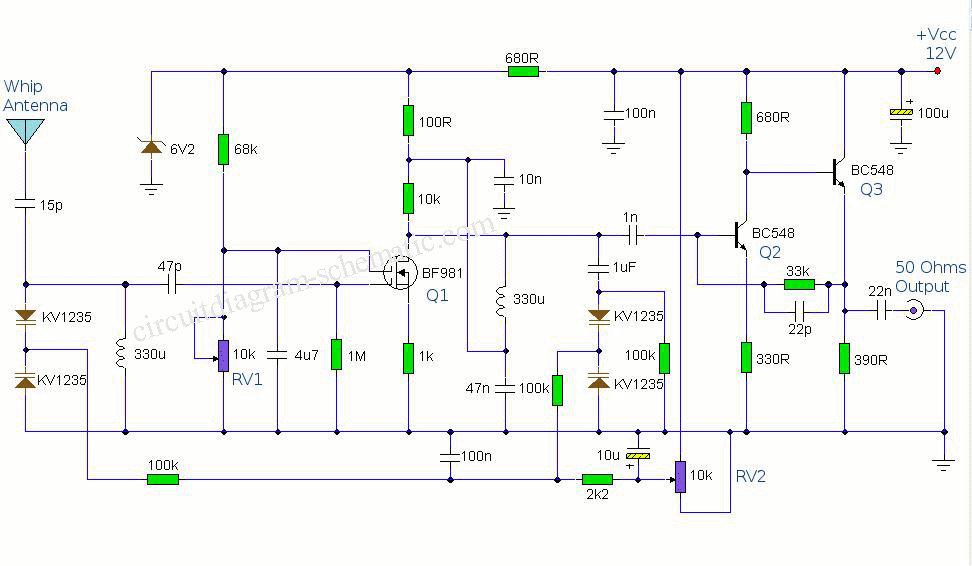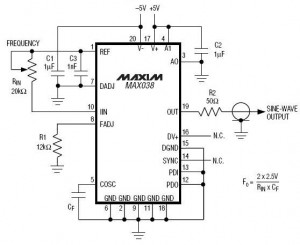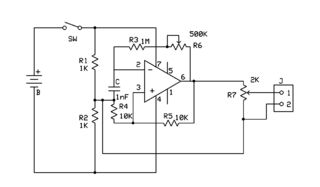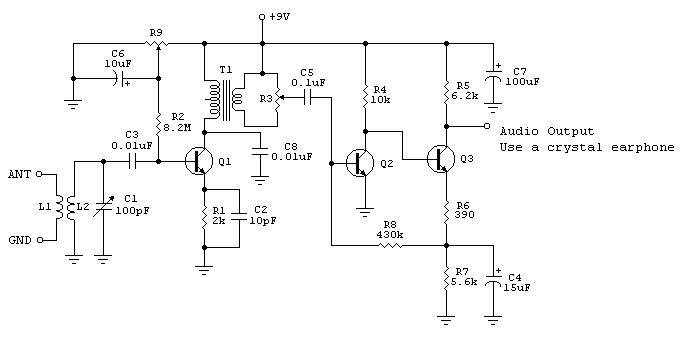
active medium wave antenna

The circuit diagram is designed to enhance the input of a telescopic whip antenna. The preamplifier is intended to operate within the medium waveband, covering frequencies from approximately 550 kHz to 1650 kHz. A tuning voltage is provided through RV2, a 10k potentiometer connected to a 12 Volt power supply. RV1 is used to adjust the amplification level, allowing for either weak or strong signal attenuation. A control voltage is applied to gate 2 of TR1, a dual-gate MOSFET, while a voltage signal is introduced via gate 1. The signal is directed through multiple inputs that include a 330 µH coil and two MOSFETs, along with KV1235 varicap diodes at the inputs and the same component at the drain terminal of the BF981 MOSFET. Both tuned circuits ensure high selectivity across the entire tuning range. To enhance the stability of the MOSFET stage, it is powered by a stable 6.2V zener supply. The circuit schematic includes a stage designed to drive low impedance (50 ohms) receivers. The output impedance of the medium stage is improved by the BF981, which consists of a composite amplifier made from Q2 (BC548) and Q3 (BC548). Q2 operates in a common emitter configuration to increase voltage gain, while Q3 functions as an emitter follower to provide low output impedance. This active antenna can be adapted for use in other frequency bands by changing the values of the 330 µH coil. A relay switch can also be employed to facilitate the adjustment of the coil's value for different bands.
The circuit effectively enhances the performance of a telescopic whip antenna by utilizing a preamplifier tailored for medium wave reception. The design incorporates a 10k potentiometer (RV2) for tuning voltage, which is essential for adjusting the sensitivity of the antenna to incoming signals. The dual-gate MOSFET (TR1) plays a critical role in signal amplification, allowing for precise control over the gain through the application of a control voltage to its gates.
The use of a 330 µH coil in conjunction with KV1235 varicap diodes ensures that the antenna maintains high selectivity, enabling it to filter out unwanted signals and focus on the desired frequency range. The BF981 MOSFET serves as a key component in maintaining the stability and performance of the circuit, supported by a 6.2V zener diode that provides a stable power supply to the MOSFET stage.
The composite amplifier configuration formed by the two BC548 transistors (Q2 and Q3) enhances the output stage, ensuring that the low impedance requirements of 50 ohm receivers are met. Q2's common emitter configuration boosts the voltage gain, while Q3's emitter follower setup minimizes output impedance, resulting in an efficient signal transfer to the receiver.
Furthermore, the design's adaptability for other frequency bands by changing the coil value or using a relay switch allows for versatility in applications, making it suitable for various medium waveband scenarios. Overall, this circuit diagram presents a sophisticated approach to improving the input capabilities of telescopic whip antennas, ensuring high performance and flexibility in signal reception.Circuit diagram is designed to strengthen the input of a telescopic whip antenna. The Preamplifier is designed to cover the medium waveband from about 550Khz to 1650Khz. Tuning voltage is supplied via RV2, a 10k potentiometer connected to the 12 Volt power supply. RV1 is controlled so that the amplified signal is weak or strong signal will be atte nuated. Control voltage applied to gate 2 of TR1, a dual-gate MOSFET, a voltage signal via gate 1; signal into multiple inputs are set through a 330uH coil and two MOSFETs KV1235 varicap diodes on inputs and by the same component in the BF981 MOSFET`s drain terminal. Both tuned circuits provide high selectivity in the entire tuning range. To help the stability of the MOSFET stage is fed from a 6. 2V zener supply stable. The following is a schematic drawing: To drive low impedance (50 ohms) receiver, the output impedance of the medium stage is enhanced by the BF981 is made of a composite amplifier Q2 BC548 and Q3 BC548.
Q2 operating in Common emitter voltages increase by more than just 2, operates in emitter follower Q3 is to provide a circuit with low output impedance. Finally, this active antenna can be used in other bands by changing the values of the 330uH coil. To perform in some bands or relay switch can be used to change the value of the coil. 🔗 External reference
The circuit effectively enhances the performance of a telescopic whip antenna by utilizing a preamplifier tailored for medium wave reception. The design incorporates a 10k potentiometer (RV2) for tuning voltage, which is essential for adjusting the sensitivity of the antenna to incoming signals. The dual-gate MOSFET (TR1) plays a critical role in signal amplification, allowing for precise control over the gain through the application of a control voltage to its gates.
The use of a 330 µH coil in conjunction with KV1235 varicap diodes ensures that the antenna maintains high selectivity, enabling it to filter out unwanted signals and focus on the desired frequency range. The BF981 MOSFET serves as a key component in maintaining the stability and performance of the circuit, supported by a 6.2V zener diode that provides a stable power supply to the MOSFET stage.
The composite amplifier configuration formed by the two BC548 transistors (Q2 and Q3) enhances the output stage, ensuring that the low impedance requirements of 50 ohm receivers are met. Q2's common emitter configuration boosts the voltage gain, while Q3's emitter follower setup minimizes output impedance, resulting in an efficient signal transfer to the receiver.
Furthermore, the design's adaptability for other frequency bands by changing the coil value or using a relay switch allows for versatility in applications, making it suitable for various medium waveband scenarios. Overall, this circuit diagram presents a sophisticated approach to improving the input capabilities of telescopic whip antennas, ensuring high performance and flexibility in signal reception.Circuit diagram is designed to strengthen the input of a telescopic whip antenna. The Preamplifier is designed to cover the medium waveband from about 550Khz to 1650Khz. Tuning voltage is supplied via RV2, a 10k potentiometer connected to the 12 Volt power supply. RV1 is controlled so that the amplified signal is weak or strong signal will be atte nuated. Control voltage applied to gate 2 of TR1, a dual-gate MOSFET, a voltage signal via gate 1; signal into multiple inputs are set through a 330uH coil and two MOSFETs KV1235 varicap diodes on inputs and by the same component in the BF981 MOSFET`s drain terminal. Both tuned circuits provide high selectivity in the entire tuning range. To help the stability of the MOSFET stage is fed from a 6. 2V zener supply stable. The following is a schematic drawing: To drive low impedance (50 ohms) receiver, the output impedance of the medium stage is enhanced by the BF981 is made of a composite amplifier Q2 BC548 and Q3 BC548.
Q2 operating in Common emitter voltages increase by more than just 2, operates in emitter follower Q3 is to provide a circuit with low output impedance. Finally, this active antenna can be used in other bands by changing the values of the 330uH coil. To perform in some bands or relay switch can be used to change the value of the coil. 🔗 External reference





